The Microsoft Surface Book 2 (15-Inch) Review: Second Time's The Charm
by Brett Howse on December 21, 2017 8:00 AM EST- Posted in
- Laptops
- Microsoft
- Surface
- Pascal
- Surface Book
- Kaby Lake Refresh
CPU Performance
Microsoft offers the smaller 13.5-inch model with a Core i5-7300U on the base model, but once you add a GPU you get the Core i7-8650U. The 15-inch model comes exclusively with the Core i7 model. This is Kaby Lake Refresh, and the refresh is that Intel doubled the physical number of cores in the CPU, going from two to four. The Core i7 models keep Hyperthreading as well, meaning you get eight threads available. Prior to this fall, the only way to get this many cores was to go with the HQ series of processors, which have a 45-Watt TDP. That would be a bit much for a laptop with a detachable tablet, so the 15-Watt Core i7-8650U is a great way to add more multithreaded performance without increasing the heat output.
Microsoft has also included the same power management software as the Surface Pro, meaning you can choose your power setting as Best Performance, Better Performance, or Best Battery Life, with the latter being the system default. This adjusts the CPU efficiency by tweaking the PL1 and PL2 levels to lower and higher results, depending on the slider setting. When in the default state, the advantage is that the system fans almost never need to be used, meaning the system is nice and quiet, but if you’re doing something that’s processor intensive, turning it up will improve the performance, with the trade-off being noise. As you’d expect, the benchmarks were run in the Best Performance mode, and battery life testing was done in Best Battery Life.
Unlike the Surface Pro, there’s no Iris GPU available, although that’s not a surprise thanks to the much more powerful GPU available in the base, and the fact that Iris isn’t offered yet in the 8th generation products.
To test CPU performance, the Surface Book 2 was run through our standard suite of laptop tests, and compared to several similar models. If you want to compare the Surface Book 2 against any device we’ve tested, please see our Notebook Bench.
PCMark
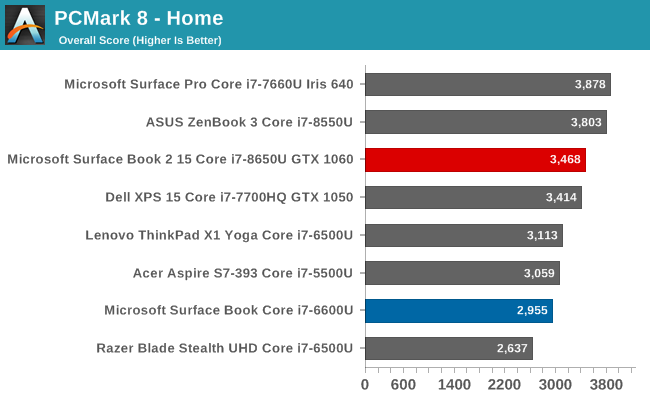
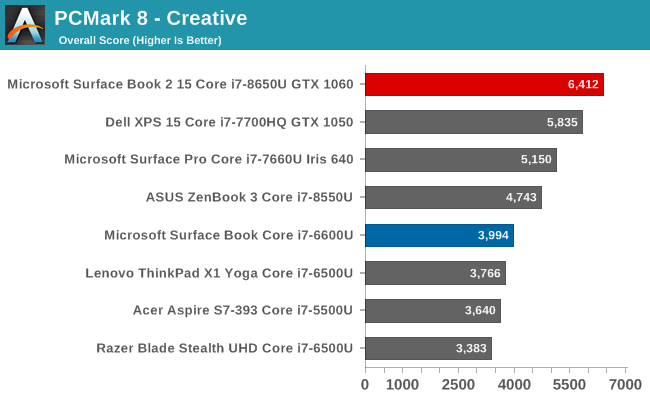
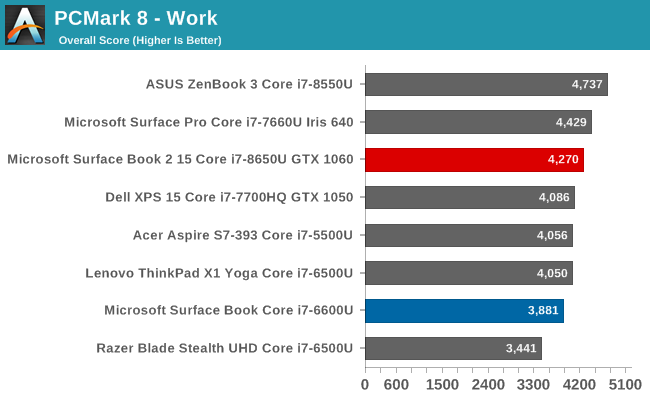
PCMark tests an entire system, from the CPU to the GPU to the storage, and all aspects of the device, including things like the display resolution, impact the results. The Surface Book 2 performs well on all of the tests, and it’s unsurprising to see it at the top for Creative, which has several GPU focused tests.
Cinebench
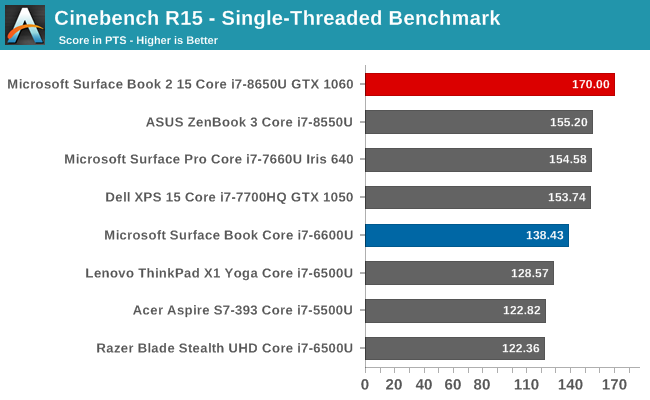
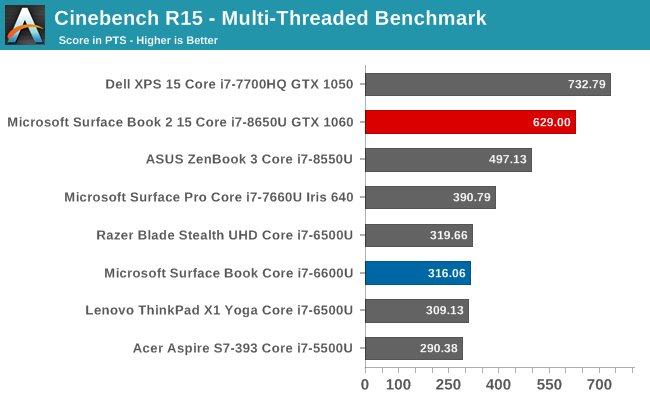
Cinebench is a rendering test which can use OpenCL, a single CPU thread, or all CPU threads to render the image. Our test focuses on the two CPU tests, and it gives us a great look at per-thread performance, and how that scales with more cores. Here the high turbo frequency of the Core i7-8650U delivers excellent single-threaded performance, and the multi-core result is also very strong. It can’t quite hang with XPS 15, but that has a 45-Watt TDP on its eight threads, allowing them to maintain a much higher turbo for the multithreaded result.
x264


Much like Cinebench, the x264 test converts a video using the CPU, and more cores with higher frequency generally wins the day here. The Surface Book 2 outperforms all other laptops with the 15-Watt TDP U series CPU in this test, but the higher TDP XPS 15 can still outperform it significantly when all cores are utilized.
Web Tests
The web is one of the most-used tools around, but performance on the web can be tied to the CPU as well as the browser itself. Over time, scripting performance in the browser continues to improve, and which browser you use will also impact performance and battery life. To make everything consistent, we utilize Microsoft Edge for all testing on Windows.
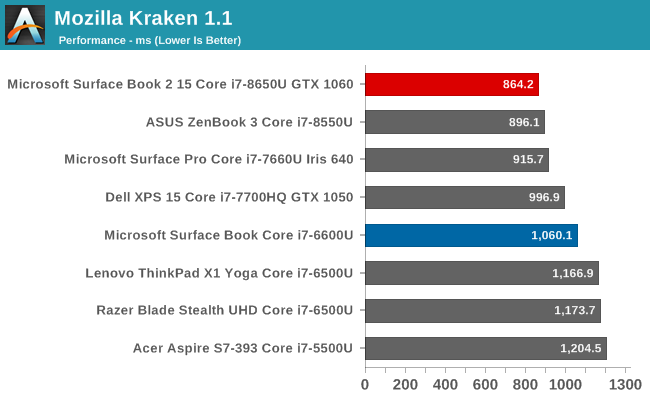
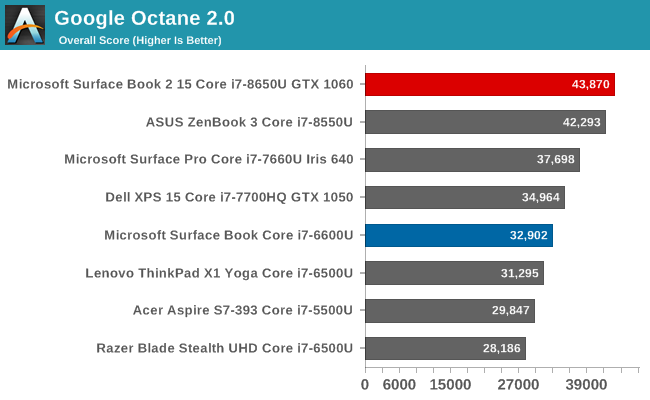
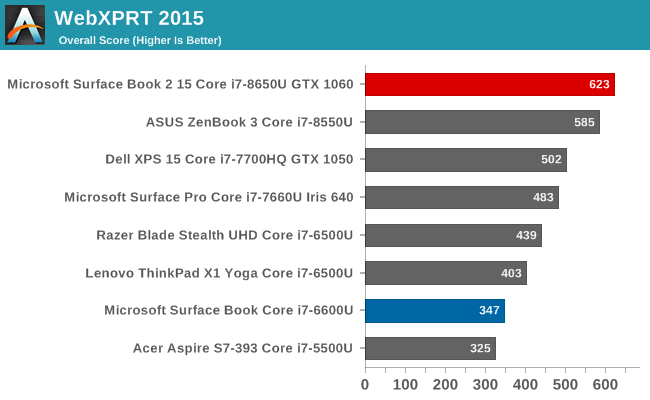
The Surface Book 2 has a slight CPU advantage over the ASUS ZenBook 3, and with that edge it creeps ahead in all of the web tests. The extra cores, as well as the updates to the browser with the Fall Creators Update, have made a significant difference over the older results. It would be nice to go back on some of these older devices to see how much of an impact the browser updates have made, if we still had the devices.
CPU Conclusion
As we saw with the ASUS ZenBook 3, the move to quad-core in the U series of Core chips has been very welcome. The performance increase is impressive over the older dual-core models, and although the eight threads run into the thermal limit quicker than the do on the higher-wattage HQ series chips, such as seen in the Dell XPS 15, the Core i7-8650U is still a very strong performer.
Storage Performance
The review unit for the Surface Book 2 shipped with the maximum drive size available, which is the 1 TB model. Thanks to the parallel nature of SSDs, this model should offer the best performance. The drive in the unit is a Samsumg PM961, which is a TLC based drive.
Performance is excellent for a TLC drive, and we do see the sequential write being affected by the TLC NAND, but all other aspects of the performance are excellent. In a device hitting this price target, a MLC version of this drive would be preferable, but it’s unlikely most people will notice the limits of this drive because it is quite good.


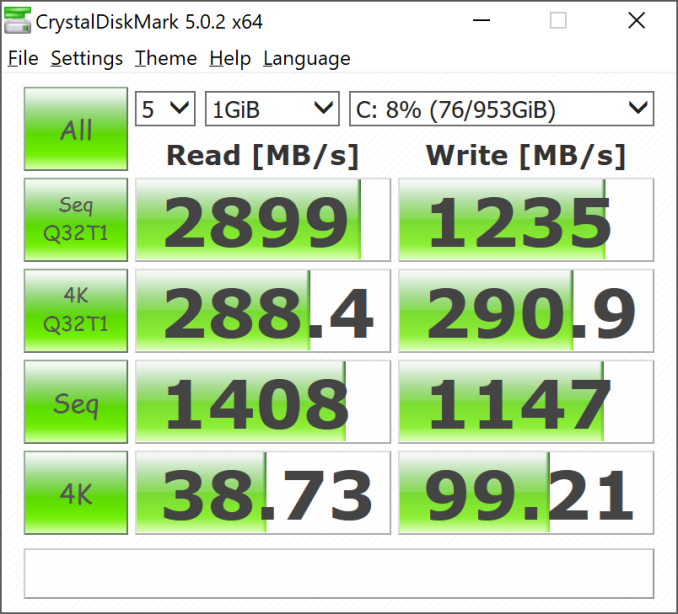








120 Comments
View All Comments
eddman - Thursday, December 21, 2017 - link
The term you are looking for is "fan"."Fanboy" basically means "a fan of something that completely lacks logic and reason and becomes aggressive while defending it".
P.S. IMO even the word "fan" is undesirable. It's the short for "fanatic".
tyaty1 - Thursday, December 21, 2017 - link
In modern language , fan and fanatic are became distinct words.HStewart - Thursday, December 21, 2017 - link
In my opinion "fanboy" is typically a term that is on tech website often in an attempt to discredit someone who has different - this I found mostly used by people that like AMD products and hate Intel. Most Intel people pretty much ignore technical sites - except if they are gamers.I am not an Intel "Fanboy" but I do support Intel - and why is simple, I have a long history of using there products and for graphics had a bad history with Ati GPU's - which is now part of AMD. i also believe that when a company creates a product you should buy from one's that created it.
But things to change - I used to pro-Microsoft almost Fanboy and refused used Android, but I have great success with Samsung Tab S series ( both an S and now S3 ) and I also have Surface like Samsung TabPro S series.
I serious doubt in my lifetime I will support AMD - it really kind of technical thing - I was highly into CPU internals at my first job and my experience with AMD and ATI maybe me not trust them. But I would state - that a lot of this influence by AMD Fanboys ( not supporter ) on the Internet who seem to attack Intel users every where they go.
HStewart - Thursday, December 21, 2017 - link
One note like everything else on Internet, this is my opinion. For example you could Intel for AMD and ATI/AMD for NVidia and all except the line about who created - have a totally different point of viewReflex - Thursday, December 21, 2017 - link
Odd that your issue with AMD would be due to technical experience. I worked on the Windows kernel for a number of years and during that time AMD developed both the Athlon and Athlon64/Opteron line. It was the technical perspective that brought me and so many other engineers towards AMD, they understood good architecture while Intel understood good marketing. Dave Cutler famously embraced AMD64 when it became clear to him what a mess IA64 was.That isn't to besmirch Intel as an engineering company. They got religion when Netburst hit its wall at only 40% of its design specification. But for Intel the limiting factor has long been marketing and management, for AMD it has always been resources. The latter reasons I respect a lot more than the former.
I've used both extensively. Currently I have a pure Intel setup across my devices (well, ARM in my phone). But I'd happily build a Ryzen based system and having read many of the technical docs around it, its a fantastic engineering achievement.
Reflex - Thursday, December 21, 2017 - link
I've pointed this out repeatedly, but TB support is a non-starter for a corporate focused laptop. It is considered a security risk as it is a direct line to the PCIe bus and can be used to easily bypass Bitlocker and other security measures. Devices with TB on them are almost never permitted for government or sensitive corporate sales.There also really isn't much demand, while I'd like to see more USB-C if only for future compatibility, to date only my phone actually uses it (and most connectors use standard USB on the other end) and eGPU or external storage simply aren't rational for a system based on a 15W CPU. The available 1060 already is bottlenecked by that CPU so I'm not certain what an eGPU would gain you (or really fast storage vs just having it on the network).
I feel like a lot of the 'must haves' you read in these comments are theoretical rather than practical. People want to believe they have certain capabilities and expect the hardware to support the scenario yet in the real world it would almost never be used and arguably be non-sensical if they did.
damianrobertjones - Friday, December 22, 2017 - link
Shhhhh! Stop it... you're making sense!Icehawk - Friday, December 22, 2017 - link
TB3 is like firewire, nobody uses it except for a few use cases. I’d much prefer a dp/mini dp port for ease of connecting to monitors. Mind you I am coming from a corporate pov here.jabber - Saturday, December 23, 2017 - link
Yeah I'm looking around at all the Thunderbolt devices...I don't and probably never will have.KPOM - Friday, December 29, 2017 - link
Even if they are concerned about TB3, they should at least have a USB-C 3.1 Gen 2 port.